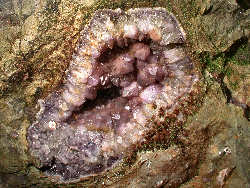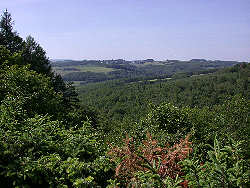Hunsrück


The Hunsrück area is a Mittelgebirge (low mountains) with a very long geologic history. The oldest rocks are 1 Ga old, from the Precambrian. Ordovician and Silurian sediments were metamorphically changed into paragneiss.
The most important era for the Hunsrück was the Devonian. At the Lower Devonian the Kaledonian Orogeny to the northwest was eroded. The Rhinean syncline, a huge bowl with a downward movement, was the place where the sand and clay was sedimented again. The results are iron rich red conglomerates, sandstones, quartzites, and slate. Most important is today the typical Hunsrück slate. During the Middle Devonian volcanic activities started, formed a submarine ridge which was soon used by a reef. The reef limestones are called Stromberger Kalke, and are up to 400 m thick.
During the Carboniferous, while nearby huge layers of coal were deposited, the Hunsrück was an area of hydrothermal activities underground. Hot water circulating through tectonic clefts was soluting minerals depositing them again in any cavity. The clefts were filled with copper rich ores, which were mined during the Middle Ages.
During the Permian, red and green sandstones were deposited, but most important is the heavy volcanism around Idar Oberstein. Huge layers of basalt were formed, with huge gas bubbles inside. The caverns were again filled by hydrothermal activity, caused by the heat of the volcanism. The bubbles were filled by semiprecious gemstones, varieties of quartz and other minerals.
The three economically most important deposits of the Hunsrück are the slates of the Devonian, the copper ores of the Carbon, and the Permian gemstones. All were mined, but are of now economic value any more. There are show mines for all three. Only the gemstones are important until today, as Idar-Oberstein has the most important production of high quality jewellery in Germany. Obviously, the gemstones which are used originate from all over the world, but not from local mines.
- Sights of This Region
 Felsenkirche Idar-Oberstein
Felsenkirche Idar-Oberstein Historisches Kupferbergwerk Fischbach
Historisches Kupferbergwerk Fischbach Schiefergrube Herrenberg
Schiefergrube Herrenberg Schinderhanneshöhle - Berger Wacken
Schinderhanneshöhle - Berger Wacken Edelsteinminen im Steinkaulenberg
Edelsteinminen im Steinkaulenberg Weinkeller Vereinigte Hospitien
Weinkeller Vereinigte Hospitien Wendalinus Höhle
Wendalinus Höhle Westwallmuseum Konz
Westwallmuseum Konz Westwallmuseum Wiltingen
Westwallmuseum Wiltingen
 Search DuckDuckGo for "Hunsrück"
Search DuckDuckGo for "Hunsrück" Hunsrück - Wikipedia
Hunsrück - Wikipedia Erlebnisregion Naturpark Saar-Hunsrück e.V.
Erlebnisregion Naturpark Saar-Hunsrück e.V.
 Index
Index Topics
Topics Hierarchical
Hierarchical Countries
Countries Maps
Maps